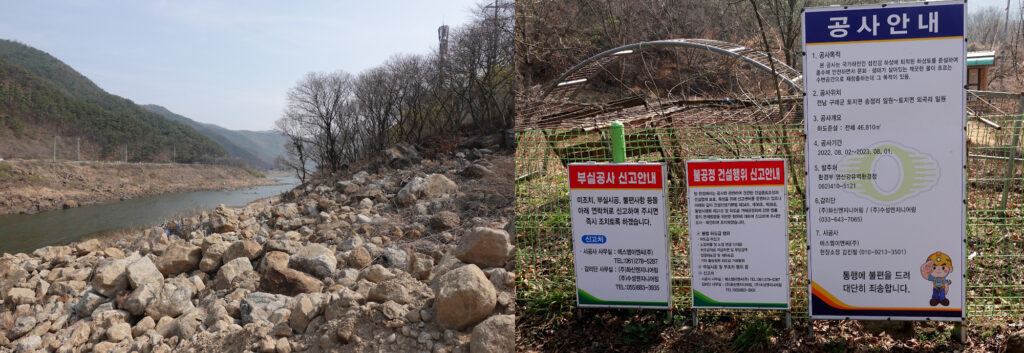Text and images by Dr Nial Moores, Director, Birds Korea, March 21st 2023

The Seomjin River flows south and southeastward, draining a largely forested catchment that includes the western slopes of Jirisan National Park. Research presented at a small workshop in November 2022 by Ms Lee Myoung Jeong highlighted the importance of the river for the globally Endangered Scaly-sided Merganser Mergus squamatus – a species protected on paper in the ROK through designation as a Nationally Endangered species and as a National Natural Monument.

According to her presentation (see table above), Ms Lee Myoung Jeong and Mr Park Mun Sik regularly counted from 35 up to 56 Scaly-sided Merganser along 70 km of the Seomjin River – with their surveys not extending as far downstream as stretches that held 4-8 individuals found during my own counts along the same river. Their research therefore helps identify the Seomjin River as one of only four rivers in the ROK to be internationally important for the Scaly-sided Merganser, based on the 1% of a population threshold criterion used by the Ramsar Convention. As is so often the case these days, however, her presentation also highlighted that many of the most important river-stretches for this and other riverine species along the Seomjin River are imminently threatened by yet more destructive river works.
As part of Birds Korea’s ongoing conservation efforts for the Scaly-sided Merganser, Ms Lee Myoung Jeong and Mr Park Mun Sik very kindly guided me between March 9th and 11th, together counting waterbirds and discussing a wide range of issues. We counted 42 Scaly-sided Merganser on March 10th along the Seomjin (just three short of the current overly-high 1% threshold of 45 individuals); and also found a dozen along one of the river’s tributaries. We also documented multiple threats to this and other species along 106 km of the river. Primarily, these include extensive road and bridge building and river bank construction apparently as part of “environmental tourism” projects. Most harmful among these to the easily-disturbed Scaly-sided Merganser is a new road to be paved later this year immediately alongside a narrow river-stretch currently favored by the species. We counted 18 along only a few 100ms of river there on March 10th, and also watched on as a car drove slowly along the pre-paved track, flushing the mergansers and other ducks.

Further downriver, we passed multiple stretches that had already been hard-dredged, with riverbank willows ripped away; and we also passed a so-called Wetland Protected Area (apparently formerly a great area for waterbirds and for River Otter Lutra lutra) that had been largely cleared of trees, burnt over and dug up, with a new river bank being constructed of gabion-mattress and rock. Further downstream still, an area which had supported 1-2 Scaly-sided Merganser in February 2022 was now birdless. Soil and rock has been dumped into the river there – according to signage there, apparently as part of a project approved by the Ministry of Environment and regional office of the Cultural Heritage Administration.



As stated explicitly in Article 35 of the National Constitution, “All citizens shall have the right to a healthy and pleasant environment. The State and all citizens shall endeavor to protect the environment.” The National Biodiversity Strategy also has clear principles calling for the cancellation of projects likely to affect key biodiversity areas; and the the Framework Act on Environment Policy Article 6, (2) also states that: “All citizens shall cooperate with environmental conservation policies of the State and local governments.”
Now is the time for the nation to strive toward reaching Carbon Zero and to reduce biodiversity loss. How then can these river-works along the Seomjin River (like so many new airports…) have been simply given the green light, in spite of obvious (and undeniable) threats to protected species like Scaly-sided Merganser and River Otter?
